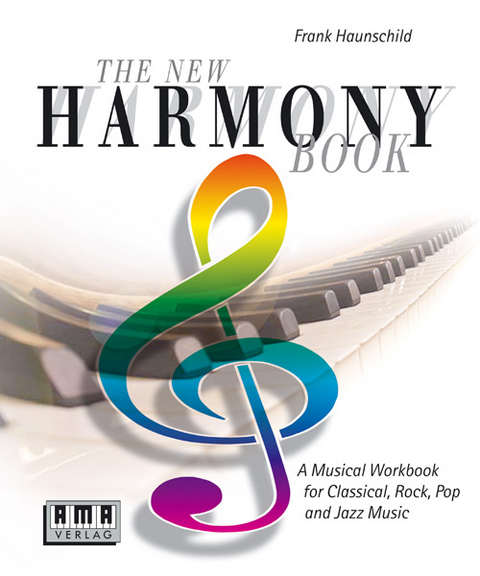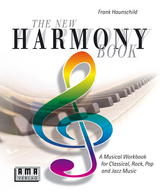The New Harmony Book
Frank Haunschild ist Professor für Jazzgitarre an der Kölner Hochschule für Musik und einer der gefragtesten Pädagogen für Jazz und Popularmusik in Deutschland. Zusätzlich ist er als Gitarrist, Komponist, Workshop-Dozent und Live- und Studiomusiker in ganz Europa tätig.
PrefacePart I: The Tonal SystemChapter 1: An introduction to notationThe system of notationThe clef questionThe ABC of notesHalftones and whole tonesThe C major scaleAccidentalsThe twelve notes within an octaveFour-four timeThe time values of notesTripletsRest signsDots and tiesOther time signatures (metres)Expression marksExercisesChapter 2: The phenomenon of the harmonic series - the basis of harmonyThe octave positionsFrequency ratios and interval proportionsThe well-tempered tuningExercisesPart II: The Rudiments of HarmonyChapter 3: The intervalsThe perfect intervalsMajor and minor - diminished and augmentedTable of intervalsThe tritoneThe use of enharmonic notesBeyond the octaveComplementary intervalsA few observations on ear trainingConsonance and dissonanceTheories of aural psychologyThe interval proportionsInterval qualities in classical counterpointThe intervals in jazzCircles of intervalsExercisesChapter 4: The triadsThe four "basic" triadsTriad inversionsThe first chord symbolsThe diatonic triads of a major scalePrimary and secondary triadsThe classical terms of harmonic functionThe fifth relationshipFunction sand cadencesAssigning the diatonic triads to the 3 functional areasThe relationship between triads a third apartThe diatonic relation shipThe half-tone relationshipSymbols for triad inversionsTriads with additional bass noteExercisesChapter 5: Four-note chords and their extensionsThe make-up and extension of four-note chordsSymbols used to designate chordsTwo index systems10 general rules for chord symbolsThe 7 main seventh chordsHow to decipher chord symbolsHow to put notes together to form a chord symbolFour-note chords as triads with an additional bass noteSlash chordsThe diatonic seventh chords of a major scaleThe cadence of the diatonic seventh chords in fourthsChord synonymsShortened four-note chordsThe relationships of four-note chords a third apartHalf-tone related four-note chordsExercisesChapter 6: The lonian systemFrom the church modes to the lonian systemChords are scales - scales are chordsA closed tonal systemScale structuresScale relationshipsThe new orderThe "avoid notes"ExercisesChapter 7: The circle of fifthsThe relationship of the tetrachordsFrom C major to G majorThe circle closesThe circle of fifths as the touchstone of relationshipsThe diatonic chords in the circle of fifthsThe keys and their accidentalsThe circle of fourthsThe circle-of-fourths exerciseExercisesChapter 8: The harmonic minor scaleThe introduction of a leading noteThe dominant seventh chord in the minor cadenceThe oriental character of the harmonic minor scaleThe gypsy minorThe harmonic minor as a closed scale systemNaming the diatonic scales of the harmonic minorThe common scales of this systemHarmonic minor half-tone relationshipsExercisesChapter 9: The melodic minor scaleEvening out the tonal leapThe melodic minor in classical and in modern musicThe melodic minor scale systemNaming the diatonic scales of the melodic minorRe-interpreting the VIIth degreeFrom super locrian to alteredMelodic minor half-tone relationshipsThe 4 principle minor keysExercisesChapter 10: A general survey of other scales1. The pentatonic scalesMajor and minor pentatonic scalesThe pentatonic scale in jazzAltered pentatonic scalesIndian and Japanese pentatonic scales2. The scales in the bluesThe minor pentatonic scale as the first blues scaleThe minor pentatonic scale with the b5 (minor blues scale)The blues scaleThe phenomenon of the "blue notes"3. The symmetrical scalesThe whole-tone scaleThe chromatic scaleHalf-tone-whole-tone and whole-tone-half-tone scalesThe half-tone-whole-tone scaleThe whole-tone-half-tone scaleFurther possibilities4. Composite scalesExercisesChapter 11: The harmonic
| Sprache | englisch |
|---|---|
| Maße | 200 x 240 mm |
| Gewicht | 427 g |
| Einbandart | Paperback |
| Themenwelt | Kunst / Musik / Theater ► Musik ► Musiktheorie / Musiklehre |
| Schlagworte | Harmonielehre • HC/Musik/Musiktheorie, Musiklehre • Jazz • Popmusik • Quintenzirkel • Rock |
| ISBN-10 | 3-927190-68-3 / 3927190683 |
| ISBN-13 | 978-3-927190-68-9 / 9783927190689 |
| Zustand | Neuware |
| Haben Sie eine Frage zum Produkt? |
aus dem Bereich




